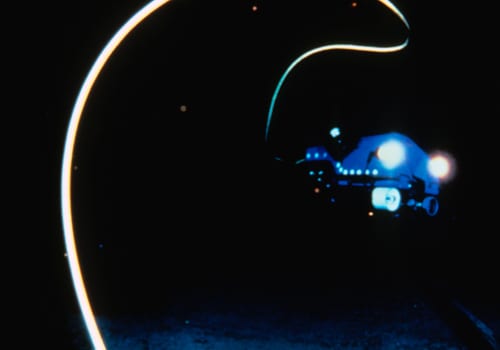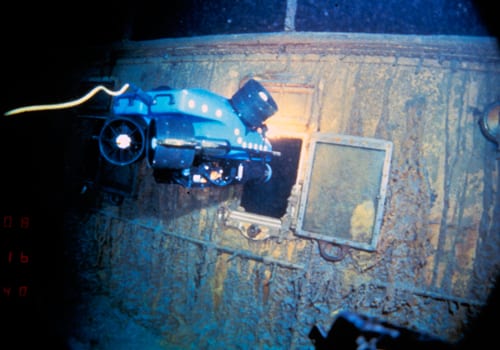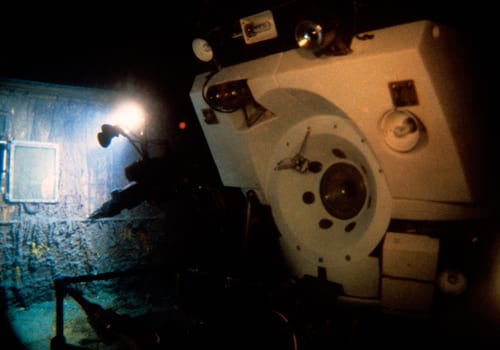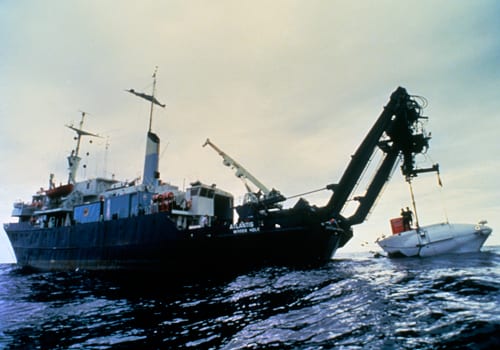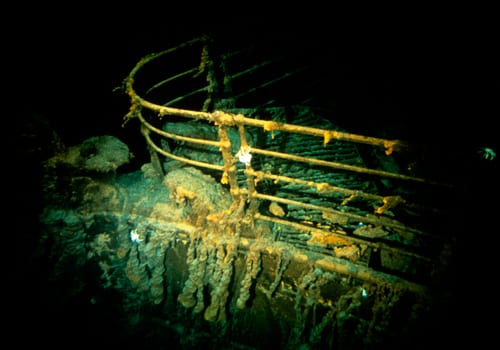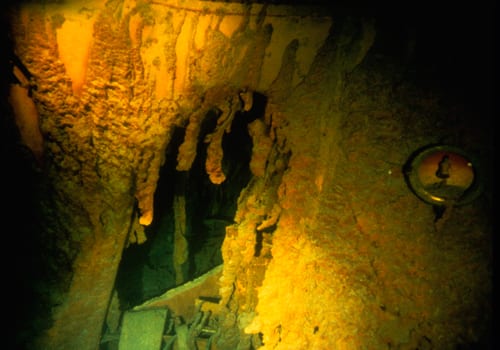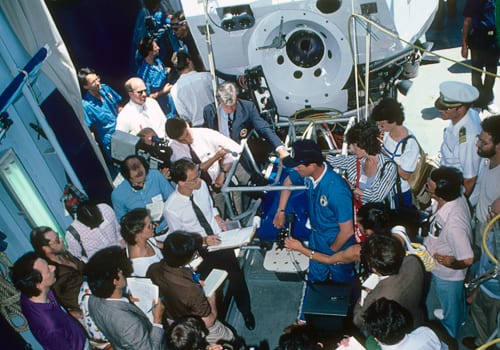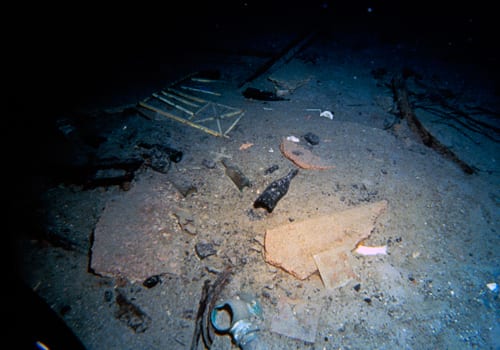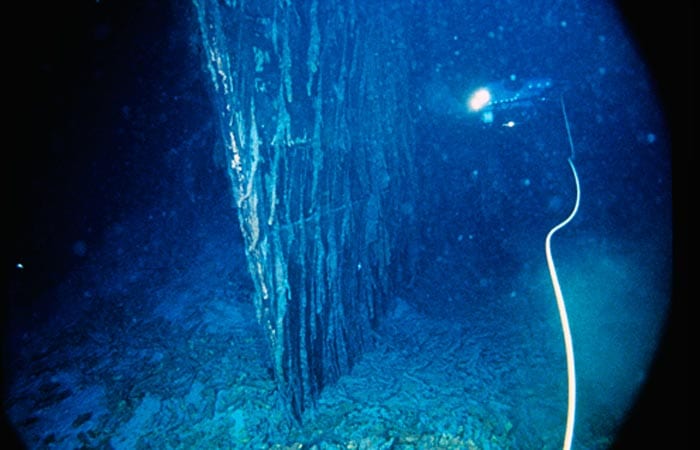
A Titanic Tale
A former Alvin pilot recalls his 1986 dives on the shipwreck
<!–
–>
In June of 1985, news came that Bob Ballard aboard the research vessel Knorr had found the RMS Titanic. Almost immediately, the rumors started that an expedition from Woods Hole Oceanographic Institution (WHOI) would go back to the wreck the next year with the deep-submersible vehicle Alvin.
The Deep Submergence Lab, or DSL, at Woods Hole was developing a new toy called Jason Jr., a small remotely operated vehicle (ROV) that would be a test bed for the concept of using fiber optics in the deep ocean. The plan evolved to put Jason Jr., or J.J., on the front of Alvin and use it to explore the interior of the wreck, to go places that it would be too dangerous for Alvin to venture.
Following the Alvin overhaul of 1985-86, the Alvin group and DSL worked together to marry the two systems for this unique trip. There were many safety considerations. The entire Jason Jr. system would take the place of Alvin’s sample basket. In the event that the ROV should become entangled and irretrievable, the entire system would have to be jettisoned so that Alvin could surface safely. This would be a big loss, but that’s the way it is; this is a risky business.
Jason Jr. had one video camera in its nose, mounted on a tilt unit. J.J. also had a 35-millimeter film camera with a strobe. Attached to Alvin by a 60-meter tether that could be reeled in and out, the ROV would be able to get into some tight spots. We could also use it to film Alvin sitting on the wreck.
Because of the weight of the Jason Jr. system, we had to remove Alvin’s port manipulator. This was no big deal, as the policy for the Titanic expedition was to take nothing from the wreck and to leave it as we found it. We still had the starboard arm for any emergency. A video camera and lights were mounted on the arm so that we could use it as a pan-and-tilt to aim the camera at Jason Jr. and film the ROV working. This arrangement we dubbed “Big Bird.”
Overcoming glitches
The research vessel Atlantis II left Woods Hole on June 6, 1986, for a four-day transit to the dive site. The weather was fine and we made good time. Good time in the oceanographic world is about 12 knots, slow by commercial standards, but economical. Once we arrived on station, an acoustic transponder navigation net was set and we dove the next day. The first dive was done by senior pilots Ralph Hollis and Dudley Foster, and chief scientist Bob Ballard. Unfortunately, no sooner did they see the forward half of the wreck than Ralph had to call up to the surface controller saying he had problems in battery tank No. 2. The dive had to be cut short.
A battery fault is a serious glitch. We got Alvin back on deck by noon and began to diagnose the problem. It turned out that the battery tank had partially flooded and would have to be changed. This had never been done at sea before, only at the dock. A battery tank weighs 2,400 pounds in air and having it swing around beneath the sub on a pitching, rolling ship is no one’s idea of a fun time. A hatch in the main deck had to be opened with Alvin positioned over it so the battery could be lowered into the hold to be serviced.
Luck was with us. The sea that day was fairly calm, a rarity for the North Atlantic. If we had any kind of rough seas, we would not have been able to pull it off. It’s just this sort of impossible task that makes the Alvin Operations Group what it is. We worked through the night and had the sub ready to dive the next morning.
On the second dive, Dudley Foster was the pilot with Martin Bowen and Bob Ballard as his passengers. This day, Alvin would perform flawlessly, but Jason Jr. would have its problems and was nearly lost on recovery. It had trouble with the latching gear that kept it in its cage on the front of Alvin. The Alvin recovery swimmers managed to save it and bring it home in the small boat. So much for dive two. Tomorrow it would be my turn.
On June 10, I made the third dive down to the Titanic. After a routine pre-dive and launch, by 7:30 a.m. my two observers, Bob Ballard and Martin Bowen, and I were on our way to the bottom. Heading to the bottom in Alvin is actually pretty relaxing. Well, as relaxing as you can get in a 6-foot sphere. It is still warm inside, not yet cooled off by the cold temperatures of the deep ocean. Once you flood the ballast tanks and sink, you leave behind the motion of the waves and begin the two-and-one-half-hour free fall to the bottom. The Titanic lies at a depth of 3,996 meters, about 2.5 miles down.
‘Let’s see how this handles’
The sphere was very crowded on these dives. Not a roomy place to begin with, it has an inside diameter of 6 feet 1 inch, and half of that space is consumed by all the electronic systems necessary to run the sub as well as life support for three days. We never had so many video cameras and VCRs working on the sub before. Both Martin and Bob were sitting in the back of the sphere with cases of videotapes sitting on their laps. There was nowhere else to put them. I even had our lunch bag hanging over my head, tied to the hatch handle.
On any trip to the bottom, there is always plenty for the pilot to do. Checking all the cameras, recorders, and sensor systems, adjusting the sub’s ballast, running the manipulators, and making sure you are ready to hit the ground running. Bottom time is too precious to have any delays once you arrive on site.
As we passed through 3,000 meters, the surface controller, who was tracking us and plotting our position, called down from the Atlantis II and told me to drive east for a couple of minutes, as it looked like we were coming right down on top of the forward half of the wreck. The Titanic lay in two pieces about a mile apart. We were headed for the bow section. It is more than 400 feet long and standing right-side-up with a slight list to port, maybe 5 degrees. After driving away and getting an all clear from above, I turned Alvin to face the wreck. I set the sonar to the 100-meter range so that I would be well oriented when we reached the bottom.
The minutes ticked by slowly. We were full of anticipation about the day’s work ahead of us. I have seen a lot of strange and wonderful things on the bottom of the ocean, but this would be the icing on the cake. At an altitude of 50 meters, I dropped the first of two 250-pound weights. That slowed the descent a bit and at 25 meters, I dropped the second one. Having already adjusted the sub’s ballast on the way down, we were now very close to neutral buoyancy. I spent a few minutes adjusting the trim, as that would affect the performance of the sub all day.
Once I got the sub neutral, I said to my passengers, “Well, let’s see how this thing handles.”
“What!” said Martin, “you mean you never drove this thing before?” He was referring to Alvin having just gone through a major overhaul, where the big 42-inch stern prop controlled by toggle switches was replaced by a high-tech system of seven smaller thrusters controlled by a joystick. Alvin became a different machine with that transformation. I had taken two months off at the end of the overhaul, and this was my first chance to drive the “new” sub.
“Relax,” I told Martin. “If you’ve driven one, you’ve driven them all.” Well, not really, but I am lucky to have a good intuitive feel for this sort of thing. It turned out to be no problem at all.
Hidden underwater for 75 years
The Titanic was the biggest sonar target I had ever seen. It more than filled the screen. The only way to get a full image would be to drive away and look at it from a greater distance.
Ballard had been studying the Titanic for years and had done the two previous dives with Ralph Hollis and Dudley Foster. He had a pretty good feel for the wreck in general and started to give me directions to the first area he wanted to explore. I had been to the bottom with Bob before on other expeditions. He has probably made more deep dives in more submersibles than any other scientist, alive or dead. I was glad to have him with me.
The first thing to do was to acquire the wreck visually. I drove across the bottom while glancing at the sonar and watching the Titanic come closer on the screen until what looked like a huge wall appeared in front of me. This was the starboard side of the wreck. Covered in thick rust, it rose up in front of me and then disappeared out of view. Alvin’s portholes point slightly downward, making it difficult to look up from inside the sub, so I could not see the top of the wreck. Also, our lights were pointed ahead, not up.
I pulled up close, about 6 feet away, to the point where we were getting good close-up video from Jason Jr., which we had powered up just before we reached the bottom. As we rose straight up from there, we saw that Titanic’s hull was covered in a thick coat of orange rust. This rust was so fragile that just the motion of us passing closely was enough to dislodge it from the hull and decrease visibility. I had to move this 18-ton sub slowly and carefully if we were to get any useful footage.
We passed the first row of round portholes about 20 feet up from the bottom. Continuing up another 15 feet was a row of rectangular windows, all with their glass intact. We didn’t stop to examine these, as we couldn’t shine enough light inside to see anything. Twenty feet above those windows, we finally came to the rail for the lifeboat deck.
The excitement level was high here. We were looking at a dramatic point on the ship that had not been seen in 75 years. People have asked me what I was feeling at this time. I have heard Martin and Bob talk about their feeling of awe in seeing the place where so many people had lived the last desperate moments of their lives, but at the time I felt none of this. I had a job to do.
Shadows and light
The biggest danger to any dive on Alvin is entanglement on the bottom. If I were to get us stuck and was unable to free the sub, we would become a bit of Titanic history ourselves. The Titanic is so far from land and so deep that there would be no real chance of rescue, only a recovery of the sub and our bodies. I had a lot on my mind and did not have the luxury of waxing romantic at the time.
I hopped the sub up over the rail and set it down on the forward end of the starboard lifeboat deck, facing aft. Secure in our parking spot with all systems go, it was time for Martin to go to work and deploy Jason Jr. On the previous two dives, Jason Jr. had some troubles and was not deployed for more than a few minutes. On this dive, it worked flawlessly. Sitting behind me to the right, Martin had his control box sitting on his lap. He flew Jason Jr. out of its cage and down the lifeboat deck to the full length of its tether, about 60 meters, and turned it around. It was an amazing sight. With the quartz lights available at the time, the farthest you could see from the Alvin was about 50 feet, and the edges of that were shadows. When Jason Jr. turned around, the whole distance between us was illuminated. We could see more than 100 feet. We even saw Alvin sitting there on the lifeboat deck in J.J.’s video. As well-lit as it was, the effect was spooky; for every thing they illuminated, they created as many shadows.
Martin flew Jason Jr. up to the square windows on the bulkhead behind the lifeboat davits. Some had glass, while others did not. The glass was so clear that Jason Jr. would bump right into it before we could tell it was there. Looking in one window, we could see a pommel horse. This must have been a gymnasium.
After exploring as much as we could from that spot, it was time to move Alvin. Bob Ballard was right on top of his game here and didn’t want to waste a minute. Martin reeled Jason Jr. into its cage and I lifted us off the deck and headed for the bridge. All the structure of the wheelhouse was gone, ripped off in the violent action of sinking or eaten by wood-boring worms. All that remained was the engine room telegraph and steering mechanism. I landed next to that and Martin deployed the ROV again. This time, we explored the bridge area and the cargo cranes just below us and forward.
When looking through a video camera, as on Jason Jr., it is sometimes hard to get a feel for the scale of things. Looking down on the cargo cranes, they looked like pieces of an erector set, but they were actually as long as the ship was wide. One gets a better perspective by looking out of Alvin’s view ports.
Jason Jr. struts it stuff
Our next directive from Ballard was to explore the bow. I lifted off the bridge deck fighting a slight current, maybe a quarter knot, and drove forward to the peak of the bow, landing gently by the open cargo hatch. With the hatch cover gone, this looked like a great opportunity for Jason Jr. to penetrate the wreck for the first time. A quick first inspection proved that it wasn’t going to happen here. The cargo hold was full of debris and mud, almost to hatch level. We were disappointed because the ship’s manifest showed a luxury car and other items that would have been interesting to see after all those years.
While sitting there, Martin flew Jason Jr. over the rail to look for the name of the ship painted on the side. We searched for almost an hour, but came up empty-handed. The paint evidently did not survive the years.
Our time on this dive was running out. It was almost 3 p.m. and time to start the 2½-hour ride to the surface. I lifted off the deck, cleared the port rail, and drove away from the wreck. To get home, I had to drop two 250-pound steel weights. We didn’t want to pollute the site with them, so I drove off at least 100 meters to a clear area with no debris and let them go. After calling the surface to tell them we were on our way up, we sat back and talked over what we had seen. It was a very successful dive and all three of us couldn’t wait for the chance to do it again. Martin and Bob would go the next day, but with a different pilot. I would have to wait five long days for my slot to come up on the rotation again. We had all of Alvin’s qualified pilots on board because no one wanted to be on vacation for this trip.
It was a lot of fun over the next few days to have a few beers at night (alcohol was allowed on research vessels then) and hash over what we had seen on our dives. This was a lot different than the scientific surveys and sampling we were used to. This was dangerous, but it was fun!
Finally, my turn arrived to pilot again and I prepared to pilot the tenth dive. My passengers would again be Martin and Bob. Jason Jr. had not worked well on the last few dives, so we had high hopes for it today.
It was a bright clear day and, after a routine pre-dive, we launched into a 6-foot sea with light winds. Almost as soon as I vented the ballast tanks and began to submerge, Martin ran a checkout of Jason Jr. As we were passing through 100 meters, we discovered an electrical problem on the ROV system. This could jeopardize the whole dive, so the decision was made to abort. I called the Atlantis and received permission to surface.
The ship came around quickly and picked us up. Once we got on deck, we decided to stay inside the sub, hoping the techs on deck would find the problem fast, and that’s just what happened. After loading a new set of weights on Alvin, we were on our way to the bottom again, with the loss of only one hour’s time.
A deep-sea picnic
Our target for that day was again the forward half of the wreck. That was fine with me. The other pilots had said it was much more dramatic than the stern, and there was a lot there I hadn’t seen yet.
We approached the Titanic from the bow. Bob wanted to get some footage with the down-looking video camera as we flew over it. Twelve years later, I would get the same view sitting in a theater, watching the opening scene from the movie Titanic. This was a great shot because it took in the whole wreck. Although it was in black-and-white, this special camera was capable of getting an image with very little light. By flying high enough, we could see the width of the ship from rail to rail.
I made three or four passes at this and headed for our main target, the grand staircase. The glass dome covering it was long gone, leaving a gaping hole 40 feet across on the uppermost portion of the wreck. The current was very strong here and I had a hard time holding Alvin still. I let Alvin lean against a pipe sticking up from the deck and reached out to hold onto the lip of the hole with the starboard manipulator. That did the trick. We were stable in our perch, looking down into the hole. Martin flew Jason Jr. from its cage and down into the dark interior of the ship.
As the staircase was made of wood, it had been consumed long ago by wood-boring worms. Jason Jr. descended deck by deck, casting an eerie light, showing a destroyed landscape where there was once such elegance.
Martin poked around at each deck, but the hanging streaks of rust broke loose at the slightest touch and reduced visibility to zero. After a couple of hours filming in the staircase hole, we moved on. Our next stop was down on the sea floor just 10 feet in front of the bow. I parked Alvin facing the knife-edge of the bow, so I could see it out the front view port. Martin unlimbered Jason Jr. for our next goal: Find the name Titanic that had eluded us on our last dive.
As I looked out my window, I could see the bow edge and both sides of the ship as they trailed aft. About 30 feet back I could see the anchors. While Martin flew Jason Jr. around the port anchor, I watched and ate my lunch. Not a bad spot for a picnic, I thought at the time.
After filming the anchors, Martin searched the area off the upper bow, but had no luck in finding the name “Titanic.” This whole scene of Jason Jr. flying around the anchors is a dramatic memory for me and is the only still photograph of the wreck I own.
After winding in Jason Jr.’s tether and parking it in its cage, I lifted Alvin off the bottom and headed up to the port lifeboat deck just aft of the bridge. It took a few minutes to find a stable position, as the current on this side of the wreck was strong.
I adjusted the variable ballast system so we sat heavily on the deck. Once we were stable, Martin uncaged J.J. and flew it away from Alvin. On this day, Ballard was ready to take a chance with his little toy. This would be the final dive where Jason Jr. would be used and we were going to penetrate the wreck here by flying J.J. in through a doorway off the lifeboat deck.
Looking out the forward view port, I watched the little ROV disappear down the interior passageway. This was an area where the senior deck officers had their quarters. Martin poked around there for about an hour. At one point we entered what we thought was the first officer’s quarters. The whole scene here was in an eerie black-and-white, as most of the paint was long gone. Visibility was low due to all the floating rust particles that J.J.‘s tether had knocked loose. One thing that stood out was a plaque that stated “Authorized Personnel Only.”
Mobbed by the media
By now we were running out of time for the dive as we still had our 2½-hour trip back to the surface. Martin began reeling in the tether, which was a tricky operation due to the bad visibility. At one point, the tether got hung up coming around a corner and we had a few tense moments. In the end, it came free and Jason Jr. landed safely back in its cage. When all was secure, I lifted Alvin off the deck and turned tail on the Titanic for the last time, for me anyway. We didn’t know it at the time, but the Titanic was to have many visitors in the years to come.
Once again I drove away from the wreck to drop my weights and we began our slow ascent. There would be one more dive with Alvin the next day, but it was mostly a sightseeing trip for Navy lieutenants who had come along. They were not qualified to run Jason Jr. and lest they be tempted, Martin tie-wrapped it into its cage so it could not be used at all.
It took four days to get back to Woods Hole. We had heard that the press would be there, but none of us in the crew were prepared to see our home dock covered with at least 500 people, satellite uplink trucks, banners, and balloons. There was Champagne, and we had interviews with the press all day—a festive end to another successful chapter in Alvin’s long history.
Slideshow
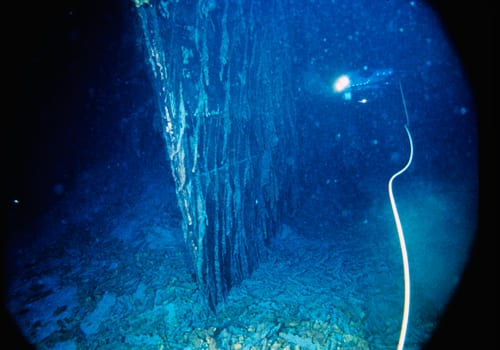
Slideshow
 Illuminated by lights from the deep-sea submersible Alvin, the bow of the sunken Titanic sticks outs like a knife edge stuck into the seafloor as the tethered robotic vehicle Jason Jr. searches for the ship's name on the hull in 1986. “While Martin flew Jason Jr. around the port anchor, I watched and ate my lunch,” wrote Alvin pilot Will Sellers. “Not a bad spot for a picnic, I thought at the time.” (Woods Hole Oceanographic Institution)
Illuminated by lights from the deep-sea submersible Alvin, the bow of the sunken Titanic sticks outs like a knife edge stuck into the seafloor as the tethered robotic vehicle Jason Jr. searches for the ship's name on the hull in 1986. “While Martin flew Jason Jr. around the port anchor, I watched and ate my lunch,” wrote Alvin pilot Will Sellers. “Not a bad spot for a picnic, I thought at the time.” (Woods Hole Oceanographic Institution)- In 1986, crammed into Alvin's titanium sphere, pilots Ralph Hollis and Dudley Foster and scientist Bob Ballard were the first human visitors to Titanic since the great ship sank in 1912. Dudley is on the left, Ballard is on the right.
- The robotic vehicle Jason Jr. operated at the end of a 60-meter fiber-optic cable, its movements controlled by a pilot inside the submersible Alvin. The Titanic expedition in 1986 was the first deep-sea test for Jason Jr.
- Jason Jr. peers into a stateroom of the sunken Titanic. (Woods Hole Oceanographic Institution)
- The deep-sea submersible Alvin pulls up alongside the RMS Titanic in 1986. “The biggest danger to any dive on Alvin is entanglement on the bottom,” wrote Alvin pilot Will Sellers. “If I were to get us stuck and was unable to free the sub, we would become a bit of Titanic history ourselves.”
- The stalwart A-frame at the stern of the research vessel Atlantis II lifts Alvin (and two divers atop it) back aboard ship. (Woods Hole Oceanographic Institution)
- The cast iron frame of a deck bench appears almost bronze in the lights from Alvin. The wooden slats had been eaten away by marine organisms. (Woods Hole Oceanographic Institution)
- A crystal light fixture dangles by its wiring from the ceiling in a first-class public room in this frame from a Jason Jr. video. A deep-sea coral grows out of the light fixture on the left. (Woods Hole Oceanographic Institution)
- Alvin's lights illuminated rust covering much of the hull. The rusted formations beneath Titanic's railing looked like orange icicles. The scientists called them “rusticles.”
- The discovery of rusticles—rusting iron—on the wreck of Titanic opened a new field of research into previously unknown microscopic deep-sea bacteria that consume the iron. (Woods Hole Oceanographic Institution)
- Reporters mob WHOI scientist Bob Ballard to hear what the 1986 expedition found. (Woods Hole Oceanographic Institution)
- Members of the Alvin Operations Group and Navy personnel pose proudly aboard the research vessel Atlantis II during the 1986 expedition to Titanic. The group includes Alvin pilot and author Will Sellers, second from left atop Alvin; Bob Ballard, second row, third form left; and Martin Bowen, second row, fifth from left, who piloted Jason Jr.


